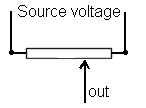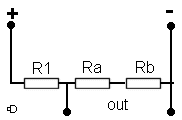



2C2 Understand that two or three resistors
can be arranged to act as a potential divider and apply the formula.
The formula for resistors in a potential divider will be provided.
The prefixes milli and kilo may be involved for some of these calculations.
Understand that two or more resistors can be arranged to act as a potential divider and apply the formula
The formula is :- ![]()
 Potential
Divider
Potential
Divider
When a connection is taken from the junction between two resistors in series this is know as as fixed potentiometer or potential divider.

Note that R1 is nearest to the Positive + rail and R2 is nearest to the Negative - rail.
With the two resistors in this configuration a voltage somewhere between the maximum and minimum would be measured at the point marked "out" depending upon the values of the resistors. This fixed combination is usually replaced by a single resistor in which the output can be changed by moving a slider along the track.

The output could be taken from anywhere along the resistor.
Without necessarily knowing it, you have all used such a potentiometer on the audio gain control on your transceiver / receiver !!!
However a potential divider can be two or more resistors but what ever number it is the resultant formula would be
![]() as
we would have to do separate calculation to end up with two
resistors.
as
we would have to do separate calculation to end up with two
resistors.
Looking at the diagram, 
you can see that the output is leaving the potential divider of R1, Ra and Rb at the link between R1 and Ra.
With Ra and Rb are in series we can simply add together their values
and come up with R2. This R2 we can use in the formula
![]() .................
simple eh ??
.................
simple eh ??

The Vout is thus dependent upon :-
Example if Volts in are 12V R1 = 10 ohms and R2 = 30 ohms then
Vout= 12 x 30/(10 + 30)
Vout = 12 x 0.75
Vout = 9V
Understand the prefixes pico, nano, micro, milli, kilo, Mega and Giga.
In the FLC you learned about milli kilo and Mega - m,k,M so there are four new ones to learn.
|
Prefix |
Prefix Name |
Scaling |
Scaling |
Units |
Example |
Comment |
|
p |
pico |
1/1,000,000,000,000 |
0.000000000001 |
1pF |
1 pico farad | New for ILC |
|
n |
nano |
1/1,000,000,000 |
0.000000001 |
1nF |
1 nano farad | New for ILC |
|
u |
micro |
1/1,000,000 |
0.000001 |
1uF |
1 micro farad | New for ILC |
|
m |
milli |
1/1,000 |
0.001 |
1mA |
1 milli amp | Learned in FLC |
|
1 |
||||||
|
k |
kilo |
1000 |
1k |
1 kilo ohms | Learned in FLC | |
|
M |
Mega |
1,000,000 |
1M |
1 mega ohms | Learned in FLC | |
|
G |
Giga |
1,000,000,000 |
1GHz |
1 giga hertz | New for ILC | |
Some students find it difficult to convert down the scale from larger to smaller numbers when it is less than 1 -- perhaps the following will help.
|
|
|
Try to see the pattern in the numbers and write out how to convert from one to another in the way you can understand.
Try with the example below. To start with always relate the number to 1
Example
Convert 0.001 micro to nano farads ?
1 micro farad = 0.000001
Thus relative to 1 farad 0.001 micro farads = 0.00000001
we have added the extra 3 zeros one for the decimal point and the other two from the 001
We now have 8 zeros
from above we know that
relative to 1 farad that 1 nano farad = 0.000000001
that is 8 zeros so 0.001 micro farads = 1 nano farads.
A student (from an early course who has now progress to an Advanced licence) suggested the following to help you remember the order down from the biggest to the smallest,
Goal = Giga
Makers = Mega
Kick = kilo
Once = 1
Many = milli
Underestimate = u for micro
Noise = nano
Pollution = pico
At Intermediate level you need to recall the Engineering Notation for key units and sub-units and be able to change between them, but there will be no calculations requiring you to use the notation.
The three zero steps in the units and sub-units translate into changes of x 103 with each level of unit or sub-unit:
Giga = x 109
Mega = x 106
Kilo = x 103
Milli = x 10-3
Micro = x 10-6
Nana = x 10-9
Pico = x 10-12
However at Intermediate level you need to recall the Engineering Notation for key units and sub-units and be able to change between them.
Units of measurement and multiple/sub-multiple prefixes.
The ILC will be taking you much much deeper into electronic theory than the FLC and the course will assume that you have a good working knowledge of all of the FLC technical basics. Some revisions will be given but mainly the ILC will be new information that needs to be fully understood stage by stage before passing onto the next part. So don't rush your learning and remember to chat to your course tutor about anything that is not clear. Even if you think that you are asking a silly question "ASK IT" !!
![]() In this part of
the syllabus is going over five items that you learned (or
should have learned) in the FLC and only introducing two
new items.
In this part of
the syllabus is going over five items that you learned (or
should have learned) in the FLC and only introducing two
new items.
However it has come to our notice that some students do not know the units of resistance, inductance, capacitance etc. These unit must be learned so that they are second nature to you so that in a question such as :-
The value of a capacitor is given in ? You readily know to tick the box next to Farads.
|
Quantity |
Symbol |
Units |
Comment |
| Potential Difference |
V |
Volts (V) | Learned in FLC |
| Current |
I |
Amps (A) | Learned in FLC |
| Resistance |
R |
Ohms |
Learned in FLC |
| Power |
P |
Watts (W) | Learned in FLC |
| Frequency |
f |
Hertz (Hz) | Learned in FLC |
| Capacitance |
C |
Farad (F) | New for ILC |
| Inductance |
L |
Henry (H) | New for ILC |